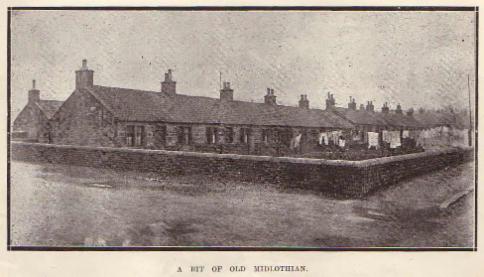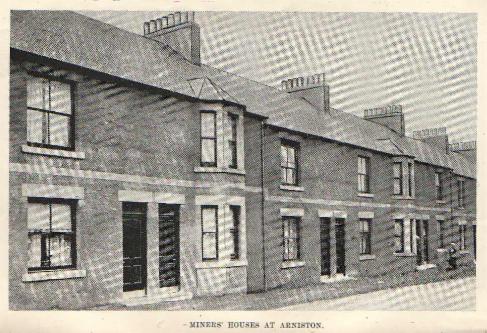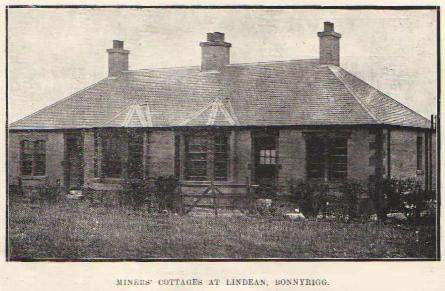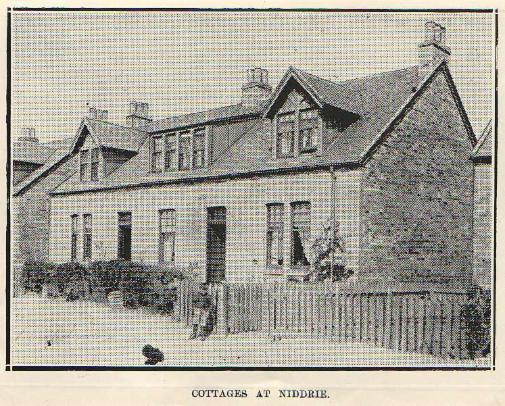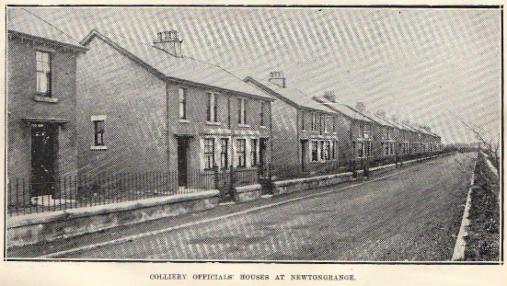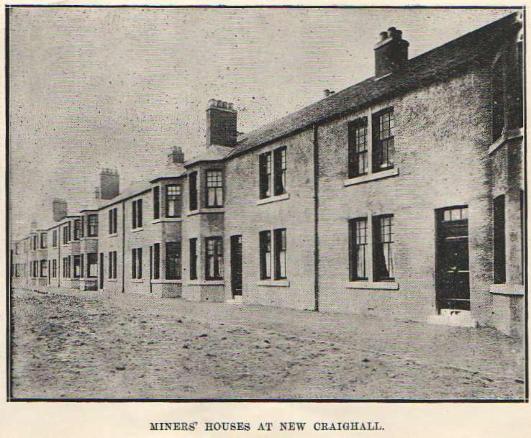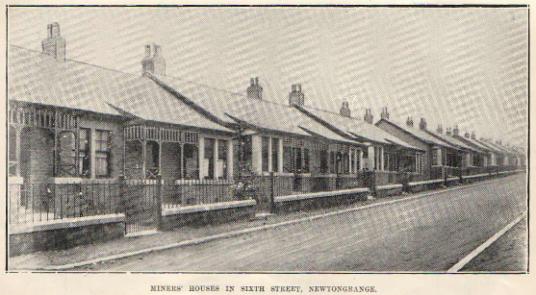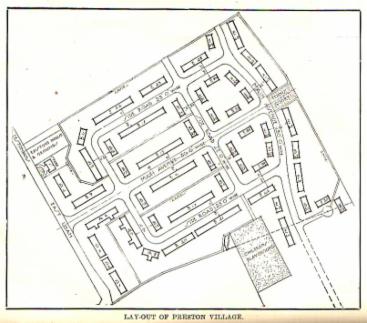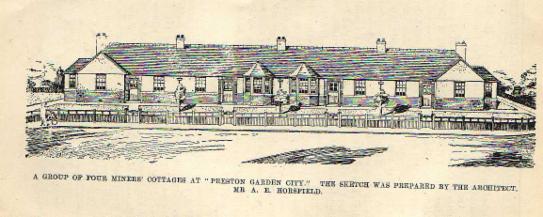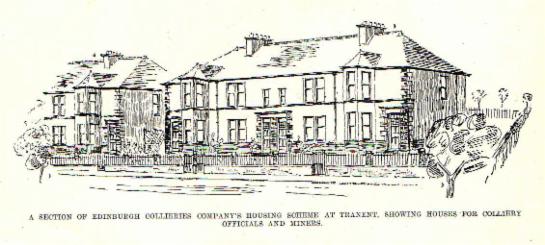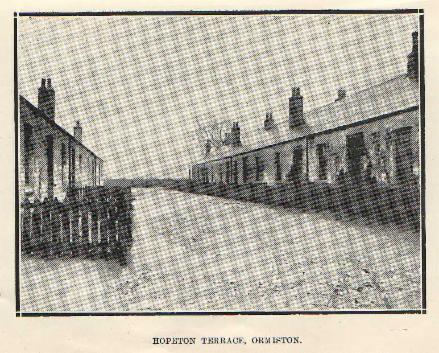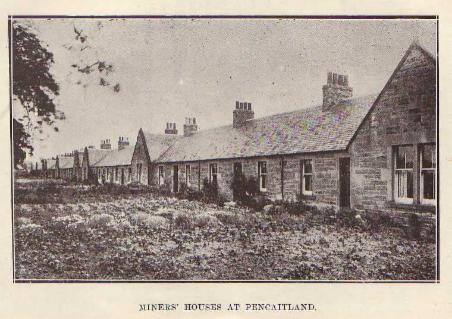Mining In Mid and East Lothian
by And. S. Cunningham, 1925
CHAPTER XII - THE TOWNS AND VILLAGES OF TODAY
IN a previous chapter I gave glimpses of the mining villages and the social life of miners and their families in 1840-41 in Mid and East Lothian, as revealed in an old Parliamentary Blue Book. Strange to say, the Act of 1842, which prohibited females at any age, and boys under 10 years of age, from working underground, was met with opposition from many operatives and their families. The opposition was offered on the ground that the withdrawal of the females from the mines meant a big reduction in the family income each fortnight. In addition to the financial aspect of the question, a reason for the objection to change was doubtless to be found in the fact that the miners and salters were slaves for centuries after other industrial toilers enjoyed complete freedom. Although 44 years had elapsed from the passing of the complete Emancipation Act of 1799, the miners and their relatives had not quite risen above the blighting effects of a life which made them a community apart from agricultural and other workers who lived in close proximity to them. This much is proved by the fact that pigs, hens, and even jackasses were housed in some of the dwellings, and the superstition that water weakened the back of pit-workers was, as indicated in a previous chapter, so deep-rooted that one of the Commissioners of 1841-44 tells us that not one out of 500 pit-workers "washed their whole person unless they chanced to have opportunities of bathing in summer" in the sea.
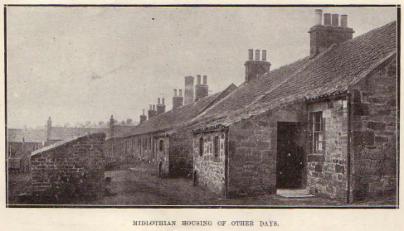 Midlothian houses of other days
Midlothian houses of other days
One of the Parliamentary Commissioners wrote:- "One of the first effects, which the collier should aim at in his efforts to improve his condition should be to establish habits of cleanliness both in his person, in his house, and his children, as the first element of creating proper self-respect, and in conciliating towards himself more of the sympathy and regard of all other classes. The exclusion of females from the pits is the first step towards raising the standard of domestic habits, and securing for the collier the decency and comforts of a, respectable home."The statute of 1842 and the action taken by the Duke of Buccleuch, the Marquis of Lothian, Mr Wardlaw Ramsay, and others had the effect this Commissioner hints at in a comparatively short time. Reporting to Parliament in 1849, the same Commissioner says:- "In the Lothians, where new colliery houses have been built, they are of a much-improved kind, as at the Marquis of Lothian's, and some excellent specimens on the property of the Duke of Buccleuch. The houses are occasionally inspected, and those families who neglect the opportunity of living in decency and cleanliness are threatened with dismissal from the works. Excellent gardens are attached to the cottages, and also ground for recreation." The Commissioner adds that admirable schoolhouses had been built by the Duke of Buccleuch and the Marquis of Lothian, while in the Tranent district the temperance movement had met with encouraging success. To the temperance movement and the sanitary improvements enforced by Sir John Hope and Sir Gr. Suttie were "attributed the comparatively light visitation" of the cholera scourge.
Since 1843 the process of evolution has gone on, and the contrasts between the housing and social conditions of the 'forties of last century and to-day are as great as that presented in the system of coal-getting. No employers of labour in industrial Scotland have done more for the housing of their workers than the coalowners have done during the past sixty years, and in no mining area in the country has more been done than in Mid and East Lothian. The magnitude of the task of providing housing in the two counties will be evident when it is remembered that since 1881 the coal output and the persons employedhave been quadrupled. The following table shows the population in 1881 and 1921 of different parishes included in the mining' areas:-
1881 1921.
COCKPEN 4,544 5,717
INVERESK 10,537 21,220
LASSWADE 8,872 10,349
MID-CALDER 1,695 3,207
NEWBATTLE 3,346 6,493
ARNISTON 1,026 1,841
PENCAITLAND 1,107 1,366
PRESTONPANS 2,573 5,154
TRANENT 5,198 9,653
The parishes of Duddingston and Liberton have in recent years come within the boundaries of the city of Edinburgh. In 1881 the population of the parish of Duddingston was 7830, while in 1901 it was 11,203. In the census of 1881 Liberton parish came out with a population of 6026, while in 1911 it was 8361. It will be observed from the table given that in 1881 the population of Newbattle was 3345, while in 1921 it was 6493. To-day it is quite 7000. Tranent, Inveresk, and other parishes show big increases. Between 1880 and 1913 two housing schemes were adopted at many of the collieries - (1) Reconstruction of the best of the old houses, and (2) the erection of a specific number of new houses a year. Up to 1913 the housing schemes kept pace with the mineral developments, but during the war and for three years after - from August 1914 to 1921 - a scarcity of labour brought about a partial suspension of building operations. In their final report, which is dated 1917, the Housing Commission of 1912, in touching on the type of houses most required, said:- 'In our opinion there should be a minimum standard of accommodation in new houses—viz., a living-room, two bedrooms, a scullery, with sink, tub, washing boiler, a food larder, a coal cellar, and, where there are water pipes, a water-closet, and with power toLocal Authorities to require the provision of a bath, with domestic hot-water supply."
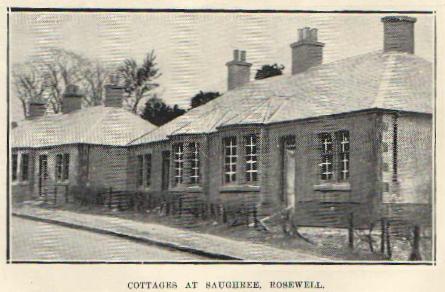 Cottages at Saughree, Rosewell
Cottages at Saughree, Rosewell
Miners cottages at Lindrean, Bonnyrigg
Years before the Housing Commission issued their report, several of the coalowners of Mid and East Lothian made dwellings of two rooms, kitchen, scullery, and a bathroom for miners' houses their minimum, and at a sitting of the Commission Mr Robert Brown, who was for many years secretary of the Mid and East Lothian Miners' Association, claimed that the houses at Newtongrange "were probably the best houses built for miners in Scotland." Among the new houses erected and old houses reconstructed between 1910 and 1914 were the following:—
Lothian Co. — Newtongrange 91 New Houses
Do. do. — Rosewell 39 New Houses, 58 Reconstructed
Arniston Coal Co. — Arniston 60 New Houses
Ormiston Coal Co. — Ormiston 66 New Houses
Niddrie & Benhar — Niddrie 33 New Houses, 3 Reconstructed
Do. — Sculleries, etc., added — 298 Reconstructed
With a view to overtaking the arrears which arose from the scarcity of labour from 1914 to 1921, and to meet probable demands for dwellings consequent upon mineral developments, the majority of the coalowners of the two counties decided in 1923 to solve the problem in a thoroughly comprehensive and satisfactory manner. Historians write of the days of David I., who founded many of our great abbeys and other religious houses, as "the period of the mortar tub." The years 1924 and 1925 will be remembered in mining areas in Mid and East Lothian as " the period of the mortar tub." It was estimated that the housing schemes launched would cost an aggregate of £400,000.
Newtongrange has in recent years developed into a town of 6500 inhabitants. The Lothian Coal Company, Limited, have even improved .upon the houses which were favourably spoken of at the Housing Commission. In 1924 a scheme of 144 new houses was completed, and in the summer of 1925 the finishing touches were given to 83 additional dwellings. Houses for officials of the colliery are two storeys in height, of four and five apartments; while the cottages for miners are one storey. Features of the houses are bathrooms, sculleries, and all modern conveniences.
In the Rosewell and Bonnyrigg district the same Company erected 14 new houses in 1914, and in the spring of 1925 as many as 40 dwellings were completed. Four and five .apartments are provided in the houses for officials, and three and four rooms in the miners' cottages. Bathrooms and all conveniences are provided in each house, and, as at Newtongrange, the front gardens are neatly fenced with parapet walls and railings. At Newtongrange and Rosewell the Institutes, which embrace reading-rooms and libraries, are the centres of indoor social life, and ample facilities are provided for outdoor recreation in the shape of football pavilions, bowling greens, etc.
Cottage at Niddrie
Colliery officials houses at Newtongrange
Miners houses at Newcraighall
Miners Houses in SIxth Street, Newtongrange
By the enterprise of the directors of the Edinburgh Collieries, Limited, a new village sprung up at Preston in 1924-25. In the former year the Company acquired three acres of ground on the fringes of the public park at Tranent, and successfully negotiated the purchase of 40 acres from the Schaw Bequest at Preston. On the Tranent ground 48 houses of the flatted villa type, of three, four, and five apartments, were erected, and 20 acres of the Preston ground were laid out on Garden City lines by Mr A. E. Horsfield, architect, Edinburgh. The main avenues running through the centre and round the borders of the village are 30 feet in width, and the side roads 25 feet. A tennis court and a children's playground are included in the lay-out. The houses for officials are two-storied, of four and five apartments; while the cottages for miners are one storey, and of three rooms. In every case bathrooms and sculleries are provided. The cottages are erected in blocks of two, four, and six. Bed roofs predominate, but here and there blue slates are introduced for the sake of variety. The village presents a striking contrast to the dingy long rows and squares which were features of the mining hamlets of fifty and a hundred years ago. The village is bounded on the north by the Firth of Forth, and on the south by Preston Tower, a structure which for centuries was the residence of the Hamiltons of Preston. In a market garden in the immediate vicinity there stands the historic Preston Cross. As far back as 1530 the chapmen of the three Lothians formed themselves into an association, and their annual fair, which was attended by buyers from all parts of the three counties, was held round the cross. Sir Walter Scott was a guild brother of the ancient fraternity, which was constituted by royal charter, and was a regular attender of the local fair. As late as. 1851 the society issued invitations to the gentlemen of the counties to the fair; but long before that year the packman and his horse had vanished, and the function had taken a social rather than a business form.
A group of four miners' cottages at "Preston Garden City" (Sketch prepared by the architect, Mr A E Horsfield)
A section of Edinburgh Collieries Company's Housing scheme at Tranent, showing houses for colliery officials and miners.
Up till 1770 Preston House, the ruins of which stand within the shadow of Preston Tower, was occupied by the Hon. John Erskine, a, brother of the Earl of Mar, who led the Jacobite Rising of 1715. Erskine took the title of Lord Grange when called to the Bench, but by Walpole's Act of 1734, which disqualified Judges from acting as Members of Parliament, he was forced to resign. He took no apparent share in the enterprise which led to his brother being attainted; but he was suspected of being concerned in Jacobite plots subsequent to the battle of Sheriffmuir. His strangest adventure was that connected with the abduction of his wife, Rachel Chiesley, a daughter of Chiesley of Dairy, who, in a fit of passionate resentment, shot the Lord President in one of the streets of Edinburgh. One morning in 1723 it was announced in Edinburgh that Lady Grange had died suddenly. Her funeral was solemnly attended by many mourners. Ten years later the true story of Lady Grange's fate leaked out. A party of Highlanders had suddenly appeared at a house in Niddry's Wynd, Edinburgh, where she was resident, and seized and gagged her. For six months she was kept in close confinement in the south of Scotland. Ultimately she was taken north through Glencoe to Loch Hourn, where she was shipped to the lonely island of St Kilda. In 1740 a letter, which she had written in 1738, reached the hands of the Lord Advocate, and she was removed to Assynt, and later to Skye, where she died in 1745. When the story of the abduction became known, the impression was that the extraordinary expedient had been resorted to to prevent Lady Grange revealing the Jacobite intrigues in which Lord Grange had doubtless been engaged.
Writing in "My Schools and Schoolmasters" of his experiences at Niddrie, where he was employed as a mason in 1825, exactly a century ago, Hugh Miller gives us an interesting glimpse of the mining village of Niddrie Mill, which was situated near the policies of the mansion-house of Niddrie. Miller says :—" The village was a wretched assembly of dingy, low-roofed, tile-covered hovels, each of which perfectly resembled all the others, and was inhabited by a rude and ignorant race of men, that still bore upon them the soil and stain of recent slavery." The old village has long since completely disappeared.
In recent years the management of the Niddrie and Benhar Coal Company, Limited, have given much attention to housing. Several of the older houses have been reconstructed, and, as shown in the table given on another page, sanitary and other improvements have been carried out on upwards of 300 dwellings. At Niddrie and Newcraighall 41 cottages were erected between 1910 and 1922, and at the latter village 52 new dwellings were completed in the summer of 1925. The houses are of the flatted villa type, each of three or four rooms, bathroom, and sculleries, and the oriel windows overlook the public park, which was opened after the village was included within the boundaries of the city of Edinburgh. Within a short distance of the new houses an institute and hall has been erected, under the auspices of the Lothians Miners' Welfare Committee, at a cost of upwards of £8000.
Coal has been worked in the Arniston district by the Dundas family for centuries, and it is apparent that the colliery has still a long lease of life before it. In 1924 and 1925 the Arniston Coal Company, Limited, which in 1924 celebrated its jubilee, made sweeping changes on Arniston village by way of adding to the home comforts of the colliery operatives. Many of the low-roofed, red-tiled houses of old Arniston, on the south side of the Edinburgh-Galashiels highway, disappeared and gave place to a range of two-storey buildings, each house embracing three or four rooms, bathroom, and all up-to-date conveniences. At Arniston 36 houses were built, and 18 dwellings reconstructed, and 34 houses of comparatively recent date have had bathrooms added. At Hunterfield 28 new houses are completed, while at Harvieston a purchase of 25 houses was made. The Company manufacture coal gas and electric light, and electric lighting has been adopted in connection with the new housing schemes. An institute was recently opened under the Welfare Scheme, and from the profits of the Gothenburg Public-house a hall, which cost £6000, has been erected.
On a fine summer day the East Lothian village of Ormiston looks like a sunny dream. As far back as the first half of the eighteenth century, John Cockburn, of Ormiston Hall, who made the parish a hive of industry, starting bleaching, spinning, and linen manufacturing works, a mine, and even a distillery and a brewery, had visions of town planning. Writing from the House of Commons to his factor in 1742, he declared for "good, handsome houses, not confusedly built," and said he would .not give his consent to the erection of any building "in the main street which was not two storeys in height." The wide main street, with its a,venue of centenarian trees, is to this day a splendid reminder of Cockburn's foresight.
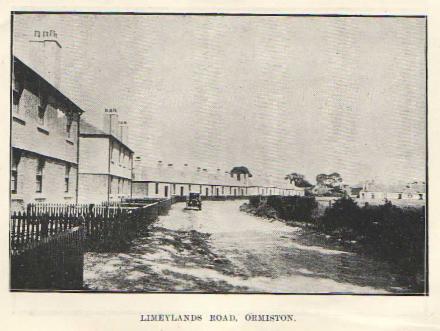 Limeylands Road, Ormiston
Limeylands Road, Ormiston
The management of the Ormiston Coal Company, Ltd., have developed the minerals of the parish on a scale not dreamt 'of by John Cockburn, and their housing schemes have met the demands consequent upon colliery extensions. They have not in their building schemes adhered to the eighteenth century command for houses of only two storeys. In a scheme of 66 houses completed in 1914 there were two-storey and single-storey dwellings, and in the 31 houses which were completed in 1925 there were flatted villas and one-storey cottages. The houses for the miners are of three apartments, with bathroom, etc., while additional accommodation is provided for colliery and farm officials. The front and back gardens are nicely kept, and the sweetness of the environment adds to the attraction of the cottages.
The Woodhall Coal Company, Limited, operates on the minerals near the village of Pencaitland. The latest houses erected for the officials and miners, by Mr Reid of Tynholme, are of the three and four room type. The dwellings are as tidy as they are comfortable, and they are to be made even more comfortable by the introduction of bathrooms. Older properties in, the quaint village are also to be brought up to date; plans for an extensive reconstruction scheme have been approved.
A point which might be mentioned in connection with housing is the fact that fifty years ago the village grocer, draper, shoemaker, ironmonger, baker, and tailor invested a considerable proportion of his savings in house property. In many villages the small trader has been practically eliminated by the Co-operative Societies. Few societies have touched house property, for the reason that it would not be a profitable investment from a financial point of view, and so with the passing of the small trader the proportion of houses which do not belong to the colliery owners gradually becomes smaller.
